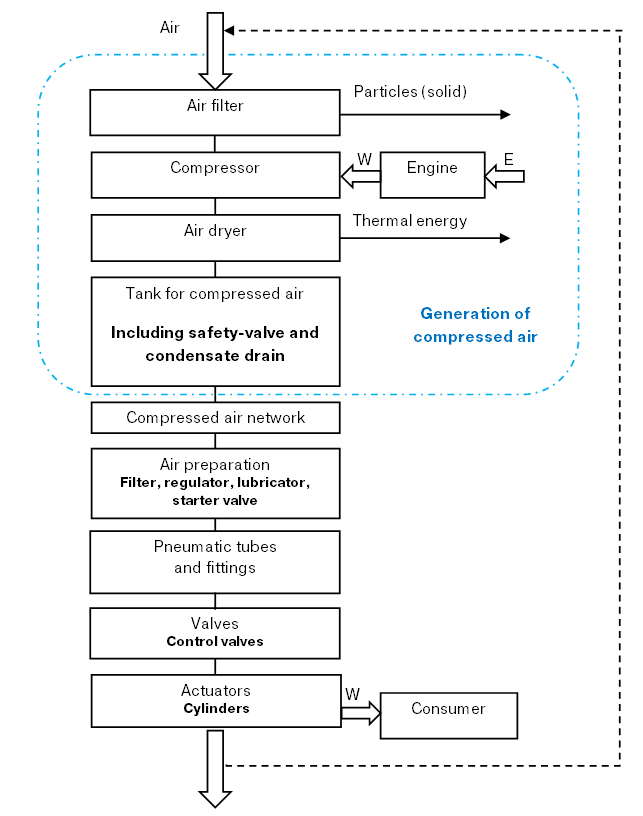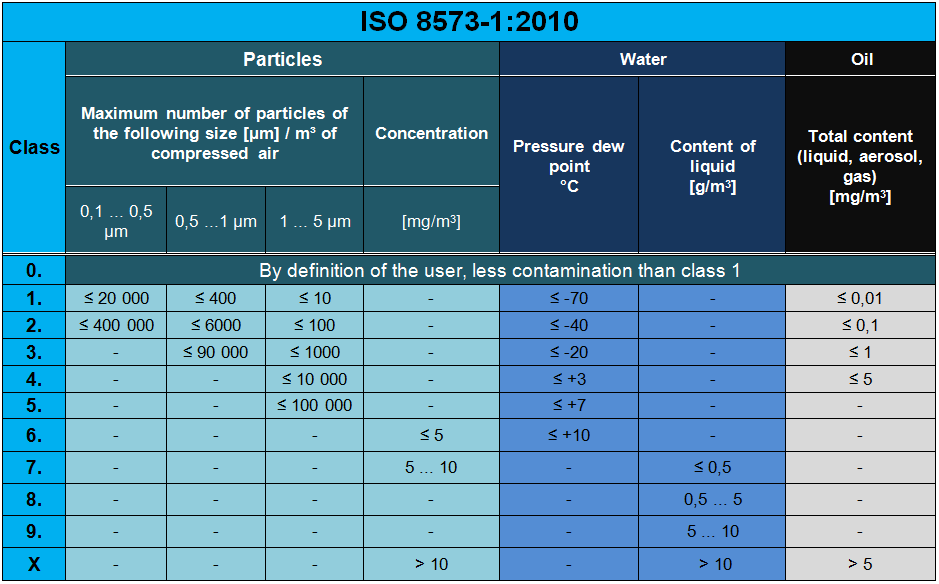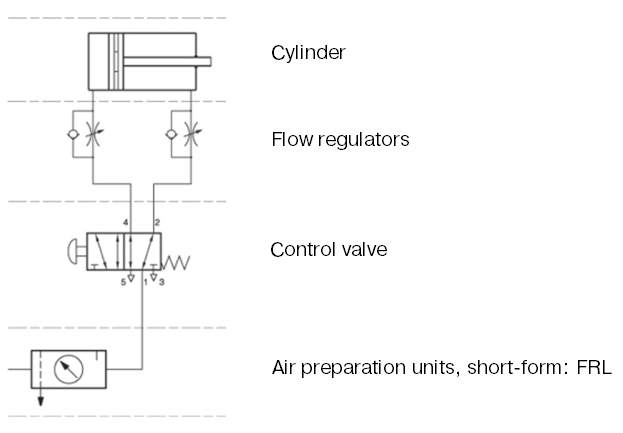Chapter 2 -The General Design of a Pneumatic System and its Components
The route of compressed air from its generation to the consumer
In pneumatics compressed air is utilized for performing mechanical work and for control. In order to do so we need different equipment to generate, treat and handle compressed air.
The graph displays the route of the environmental air from the compressor to the consumer of compressed air:
When designing a pneumatic system, typically the individual elements are distributed spatially depending on their task. Although they are spatially separated, they are still connected systematically.
Generation and transportation of compressed air
We will have a brief look at the following elements of pneumatic systems.
Air filter
The air filter is integrated into the intake of the compressor. It prevents large, polluting particles on the outside from entering the air system. Through filtration, a major portion of unwanted particles can be kept out of the system.
Compressor
The task of the compressor is to compress the air to the required pressure and in the required volume. The engine consumes energy. The compressor transforms this energy and stores it as compressed air. Unfortunately losses are severe. The screw compressor is the most common type. Piston compressors are used as well.
Air Dryer and Pre-Filters
When air is compressed it loses its ability to hold water. Therefore water remains when air is compressed. As this water, the condensate, would be disturbing the following processes, it needs to be removed from the pneumatic system. In a so called refrigeration dryer the water condensates and can be removed. There are also absorption dryers in which the water is absorbed by special materials.
The compressed air is also regularly polluted by oil from the compressor or particles that have not been caught by its intake filter. Those can cause problems in the pneumatic system, e.g. in the valves. Often times they are separated from the compressed air by using a central filter unit.
We will cover air preparation in a later chapter of the course in detail.
Tanks
Tanks are used for storing compressed air temporarily. The storage guarantees that the demand can be covered securely. Often times you can find a condensate drain at the tank. The condensate can then drain off through a valve. The drain is actuated manually or automatically.
Compressed Air Network
The task of the network is to distribute the compressed air from the compressor to the user(s). The size of its tubes is important because it has a significant influence on the security of supply.
In general:
- The longer the tubes the bigger the loss of pressure due to friction.
- The more users are connected the bigger the orifice of the tubes needs to be.
The Quality of Compressed Air
The operational safety of an air system is directly linked to the quality of the compressed air.
In general:
- A „better“ = cleaner air increases the operational safety of the system as the risk of blockage and wear is reduced.
- Please take into consideration that the manufacturers of the components and devices communicate the quality requirements for the air in use. Air quality is standardized by ISO 8573-1:2010.
Contaminants and purity classes – the standard ISO 8573-1
Particles, oil and water are the most important contaminants in compressed air. For each of these three there are purity classes in the standard.
Purity classes in accordance to standard ISO 8573-1
For example: ISO 8573-1:2010 [4:3:3]
Particles = class 4, water = class 3, oil = class 3
High quality compressed air is (by definition) 100% oil free = class 0. Air of this quality is required in medical applications, the food-industry and electronic industry.
Let's not forget air pollution!
When designing a compressed air system take environmental factors into consideration! Air pollution is concentrated when the air is compressed. Industries with high emissions in the neighbourhood can be of severe impact. Other factors such as a high concentration of ozone can influence your system and eventually harm seal materials as well. Never ignore climatic conditions. The dryer has to be more capable in a hot and humid environment.
Therefore it is important that…
- we know what kind of air is sucked into our compressor
- we make sure that after compressing the air is dried, cleaned and potential oil is separated from it
- we consider the influence of the environmental factors (climate and pollution)
- components with very high loads are lubricated where necessary
.. in order to guarantee a safe operation.
The most important elements at the machine-level
The sketch exemplifies a pneumatic system at the machine-level:
The individual elements are represented by ISO-symbols, which are connected with lines. They display the route of the compressed air. In order to get a better overview we position the air preparation on the bottom and the actuators on the top of the drawing.
We can form logic groups of the elements – as you can see in the drawing above:
- Air preparation
- Filter
- Pressure regulator
- Lubricator
- Switch-on valve
- Soft start
- ...
- Directional control valves
- Other types of control valves
- Logic elements
- ...
Flow control valves, check-valves
- Flow control valves, uni- or bidirectional
- Exhaust flow-regulators
- Non-return valves = check valves
- ...
- Actuators, cylinders
- Cylinders
- Rodless cylinders
- Rotary cylinders
- ...
- Tubes and fittings
- To distribute compressed air and to connect different components
Hafner-Pneumatik distributes its products under the following groups and categories:
We will study the function of all these groups in later chapters.






